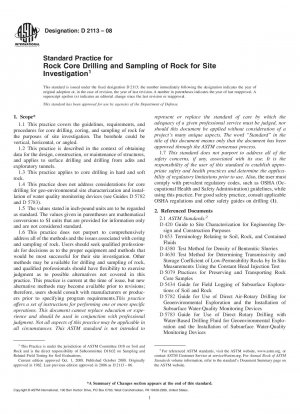ASTM D2113-08
Standard Practice for Rock Core Drilling and Sampling of Rock for Site Investigation
- Standard No.
- ASTM D2113-08
- Release Date
- 2008
- Published By
- American Society for Testing and Materials (ASTM)
- Status
- Replace By
- ASTM D2113-14
- Latest
- ASTM D2113-14
- Scope
Rock cores are samples of record of the existing subsurface conditions at given borehole locations. The samples are expected to yield significant indications about the geological, physical, and engineering nature of the subsurface for use in the design and construction of an engineered structure (see Guide D 420
. The core samples need to be preserved using specific procedures for a stipulated time (Practices D 5079 ). The period of storage depends upon the nature and significance of the engineered structure. Rock cores always need to be handled such that their properties are not altered in any way due to mechanical damage or changes in ambient conditions of moisture and temperature or other environmental factors.
1.1 This practice covers the guidelines, requirements, and procedures for core drilling, coring, and sampling of rock for the purposes of site investigation. The borehole could be vertical, horizontal, or angled.
1.2 This practice is described in the context of obtaining data for the design, construction, or maintenance of structures, and applies to surface drilling and drilling from adits and exploratory tunnels.
1.3 This practice applies to core drilling in hard and soft rock.
1.4 This practice does not address considerations for core drilling for geo-environmental site characterization and installation of water quality monitoring devices (see Guides D 5782 and D 5783).
1.5 The values stated in inch-pound units are to be regarded as standard. The values given in parentheses are mathematical conversions to SI units that are provided for information only and are not considered standard.
1.6 This practice does not purport to comprehensively address all of the methods and the issues associated with coring and sampling of rock. Users should seek qualified professionals for decisions as to the proper equipment and methods that would be most successful for their site investigation. Other methods may be available for drilling and sampling of rock, and qualified professionals should have flexibility to exercise judgment as to possible alternatives not covered in this practice. This practice is current at the time of issue, but new alternative methods may become available prior to revisions; therefore, users should consult with manufacturers or producers prior to specifying program requirements.
This practice offers a set of instructions for performing one or more specific operations. This document cannot replace education or experience and should be used in conjunction with professional judgment. Not all aspects of this practice may be applicable in all circumstances. This ASTM standard is not intended to represent or replace the standard of care by which the adequacy of a given professional service must be judged, nor should this document be applied without consideration of a project''s many unique aspects. The word “Standard” in the title of this document means only that the document has been approved through the ASTM consensus process.1.7 This standard does not purport to address all of the safety concerns, if any, associated with its use. It is the responsibility of the user of this standard to establish appropriate safety and health practices and determine the applicability of regulatory limitations prior to use. Also, the user must comply with prevalent regulatory codes, such as OSHA (Occupational Health and Safety Administration) guidelines, while using this practice. For good safety practice, consult applicable OSHA regulations and other safety guides on drilling (1).
ASTM D2113-08 Referenced Document
- ASTM D420 Standard Guide to Site Characterization for Engineering Design and Construction Purposes
- ASTM D4380 Standard Test Method for Density of Bentonitic Slurries
- ASTM D4630 Standard Test Method for Determining Transmissivity and Storage Coefficient of Low-Permeability Rocks by In Situ Measurements Using the Constant Head Injection Test
- ASTM D5079 Standard Practices for Preserving and Transporting Rock Core Samples
- ASTM D5434 Standard Guide for Field Logging of Subsurface Explorations of Soil and Rock
- ASTM D5782 Standard Guide for Use of Direct Air-Rotary Drilling for Geoenvironmental Exploration and the Installation of Subsurface Water-Quality Monitoring Devices
- ASTM D5783 Standard Guide for Use of Direct Rotary Drilling with Water-Based Drilling Fluid for Geoenvironmental Exploration and the Installation of Subsurface Water-Quality Monitoring Devices
- ASTM D5876 Standard Guide for Use of Direct Rotary Wireline Casing Advancement Drilling Methods for Geoenvironmental Exploration and Installation of Subsurface Water-Quality Monitoring Devices
- ASTM D6032 Standard Test Method for Determining Rock Quality Designation (RQD) of Rock Core
- ASTM D6151 Standard Practice for Using Hollow-Stem Augers for Geotechnical Exploration and Soil Sampling
- ASTM D653 Standard Terminology Relating to Soil, Rock, and Contained Fluids
ASTM D2113-08 history
- 2014 ASTM D2113-14 Standard Practice for Rock Core Drilling and Sampling of Rock for Site Exploration
- 2008 ASTM D2113-08 Standard Practice for Rock Core Drilling and Sampling of Rock for Site Investigation
- 2006 ASTM D2113-06 Standard Practice for Rock Core Drilling and Sampling of Rock for Site Investigation
- 1999 ASTM D2113-99 Standard Practice for Rock Core Drilling and Sampling of Rock for Site Investigation
